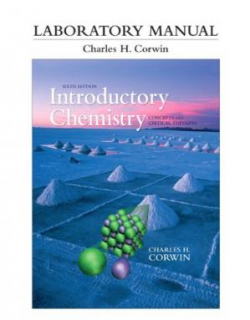Laboratory Manual for Introductory Chemistry: Concepts and Critical Thinking

Buy online ($)
Type
E-Book
Authors
Corwin ( Charles H. )
ISBN 10
0321750942
ISBN 13
9780321750945
Category
Chemistry
[ Browse Items ]
Publication Year
2012
Publisher
Pearson, United States
Subject
Chemistry -- Laboratory manuals. Chemistry -- Problems, exercises, etc. Chemistry.
Description
Contents:
SAFETY PRECAUTIONS LOCKER INVENTORY WASTE DISPOSALEXPERIMENTS1 Introduction to Chemistry Topic: The Scientific MethodA. Instructor DemonstrationsB. Student Experiments2 Instrumental Measurements Topic: The Metric SystemA. Length MeasurementB. Mass MeasurementC. Mass and Volume of an unknown solidD. Volume MeasurementsE. Temperature Measurements3 Density of Liquids and Solids Topic: DensityA. Instructor DemonstrationB. Density of WaterC. Density of an Unknown LiquidD. Density of a Rubber StopperE. Density of an Unknown SolidF. Thickness of Aluminum Foil4 Freezing Points and Melting Points Topic: Change of Physical StateA. Cooling Curve and Freezing PointB. Melting Point of an Unknown5 Physical Properties and Chemical Properties Topic: Physical and Chemical PropertiesA. Physical PropertiesB. Chemical Properties6 "Atomic Fingerprints" Topic: Emission Spectra and Electron Energy LevelsA. Continuous Spectrum - White LightB. Line Spectrum - HydrogenC. Line Spectra - Helium, Neon, Argon, Krypton, and MercuryD. Identifying Unknown Elements in a Fluorescent Light7 Families of Elements Topic: The Periodic TableA. Analysis of Known SolutionsB. Analysis of an Unknown Solution8 Identifying Cations in Solution Topic: Qualitative Cation AnalysisA. Analysis of a Known Cation SolutionB. Analysis of an Unknown Cation Solution9 Identifying Anions in Solution Topic: Qualitative Anion AnalysisA. Analysis of a Known Anion SolutionB. Analysis of an Unknown Anion Solution10 Analysis of a Penny Topic: Writing and Balancing Chemical EquationsA. Instructor Demonstrations-Combination ReactionsB. Decomposition ReactionsC. Single-Replacement ReactionsD. Double-Replacement ReactionsE. Neutralization ReactionsF. Percentages of Copper and Zinc in a Penny11 Determination of Avogadro's Number Topic: Avogadro's Number and the Mole ConceptA. Calibrating a Dropper PipetB. Calculating Molecules in the MonolayerC. Determining Avogadro's Number12 Empirical Formulas of Compounds Topic: Empirical FormulaA. Empirical Formula of Magnesium OxideB. Empirical Formula of Copper Sulfide13 Analysis of Alum Topic: Percent Composition and Empirical Formula--A. Percentage of Water in Alum HydrateB. Percentage of Water in an Unknown HydrateC. Water of Crystallization in an Unknown Hydrate14 Decomposing Baking Soda Topic: Mass-Mass Stoichiometry and Percent YieldA. Percent Yield of Na2CO3 from Baking Soda--B. Percentage of NaHCO3 in an Unknown Mixture15 Precipitating Calcium Phosphate Topic: Mass-Mass Stoichiometry and Percent YieldA. Percent Yield of Ca3(PO4)2 from CaCl2B. Percentage of CaCl2 in an Unknown Mixture16 Generating Hydrogen Gas Topic: Mass-Volume Stoichiometry and Combined Gas LawA. Molar Volume of Hydrogen GasB. Atomic Mass of an Unknown Metal17 Generating Oxygen Gas Topic: Mass-Volume Stoichiometry and Combined Gas LawA. Percentage of KClO3 in a Known MixtureB. Percentage of KClO3 in an Unknown Mixture18 Molecular Models and Chemical Bonds Topic: Chemical Bonding and Electron Dot FormulasA. Molecular Models with Single BondsB. Molecular Models with Double BondsC. Molecular Models with Triple BondsD. Molecular Models with Two Double BondsE. Unknown Molecular Models19 Analysis of Saltwater Topic: Solubility and Solution ConcentrationA. Solutes and SolventsB. Rate of DissolvingC. Demonstration of SupersaturationD. Concentration of Sodium Chloride in Saltwater20 Analysis of Vinegar Topic: Acid-Base TitrationsA. Preparation of Standard Sodium Hydroxide SolutionB. Concentration of Acetic Acid in Vinegar21 Electrical Conductivity of Aqueous Solutions Topic: Net Ionic EquationsA. Conductivity Testing-Evidence for Ions in Aqueous SolutionB. Conductivity Testing-Evidence for a Chemical ReactionC. Net Ionic Equations-A Study Assignment22 Activity Series of Metals Topic: Oxidation-Reduction ReactionsA. Oxidation Numbers of ManganeseB. Oxidation Numbers of ChromiumC. Oxidation Numbers of SulfurD. Oxidation Numbers of NitrogenE. Oxidation-Reduction EquationsF. Activity Series and an Unknown Metal23 Organic Models and Functional Groups Topic: Classes of Organic CompoundsA. Molecular Models of HydrocarbonsB. Molecular Models of Hydrocarbon DerivativesC. Unknown Molecular Models24 Separation of Food Colors and Amino Acids Topic: Separation of Biochemical CompoundsA. Separation of Food Colors by Paper ChromatographyB. Identification of Amino Acids by Paper Chromatography 25. Laboratory Instruments and TechniqueTopic: Lab Final Exam--A. Lab --Practical Exam--B. Lab --Written Exam--APPENDICES-- A. Laboratory Burner-- B. Decigram Balance-- C. CentigramBalance D Milligram Balance E Volumetric Pipet F Activity Series for Metals G Solubility Rules H Laboratory NotebookI Glossary J Answers to Prelaboratory Assignments
SAFETY PRECAUTIONS LOCKER INVENTORY WASTE DISPOSALEXPERIMENTS1 Introduction to Chemistry Topic: The Scientific MethodA. Instructor DemonstrationsB. Student Experiments2 Instrumental Measurements Topic: The Metric SystemA. Length MeasurementB. Mass MeasurementC. Mass and Volume of an unknown solidD. Volume MeasurementsE. Temperature Measurements3 Density of Liquids and Solids Topic: DensityA. Instructor DemonstrationB. Density of WaterC. Density of an Unknown LiquidD. Density of a Rubber StopperE. Density of an Unknown SolidF. Thickness of Aluminum Foil4 Freezing Points and Melting Points Topic: Change of Physical StateA. Cooling Curve and Freezing PointB. Melting Point of an Unknown5 Physical Properties and Chemical Properties Topic: Physical and Chemical PropertiesA. Physical PropertiesB. Chemical Properties6 "Atomic Fingerprints" Topic: Emission Spectra and Electron Energy LevelsA. Continuous Spectrum - White LightB. Line Spectrum - HydrogenC. Line Spectra - Helium, Neon, Argon, Krypton, and MercuryD. Identifying Unknown Elements in a Fluorescent Light7 Families of Elements Topic: The Periodic TableA. Analysis of Known SolutionsB. Analysis of an Unknown Solution8 Identifying Cations in Solution Topic: Qualitative Cation AnalysisA. Analysis of a Known Cation SolutionB. Analysis of an Unknown Cation Solution9 Identifying Anions in Solution Topic: Qualitative Anion AnalysisA. Analysis of a Known Anion SolutionB. Analysis of an Unknown Anion Solution10 Analysis of a Penny Topic: Writing and Balancing Chemical EquationsA. Instructor Demonstrations-Combination ReactionsB. Decomposition ReactionsC. Single-Replacement ReactionsD. Double-Replacement ReactionsE. Neutralization ReactionsF. Percentages of Copper and Zinc in a Penny11 Determination of Avogadro's Number Topic: Avogadro's Number and the Mole ConceptA. Calibrating a Dropper PipetB. Calculating Molecules in the MonolayerC. Determining Avogadro's Number12 Empirical Formulas of Compounds Topic: Empirical FormulaA. Empirical Formula of Magnesium OxideB. Empirical Formula of Copper Sulfide13 Analysis of Alum Topic: Percent Composition and Empirical Formula--A. Percentage of Water in Alum HydrateB. Percentage of Water in an Unknown HydrateC. Water of Crystallization in an Unknown Hydrate14 Decomposing Baking Soda Topic: Mass-Mass Stoichiometry and Percent YieldA. Percent Yield of Na2CO3 from Baking Soda--B. Percentage of NaHCO3 in an Unknown Mixture15 Precipitating Calcium Phosphate Topic: Mass-Mass Stoichiometry and Percent YieldA. Percent Yield of Ca3(PO4)2 from CaCl2B. Percentage of CaCl2 in an Unknown Mixture16 Generating Hydrogen Gas Topic: Mass-Volume Stoichiometry and Combined Gas LawA. Molar Volume of Hydrogen GasB. Atomic Mass of an Unknown Metal17 Generating Oxygen Gas Topic: Mass-Volume Stoichiometry and Combined Gas LawA. Percentage of KClO3 in a Known MixtureB. Percentage of KClO3 in an Unknown Mixture18 Molecular Models and Chemical Bonds Topic: Chemical Bonding and Electron Dot FormulasA. Molecular Models with Single BondsB. Molecular Models with Double BondsC. Molecular Models with Triple BondsD. Molecular Models with Two Double BondsE. Unknown Molecular Models19 Analysis of Saltwater Topic: Solubility and Solution ConcentrationA. Solutes and SolventsB. Rate of DissolvingC. Demonstration of SupersaturationD. Concentration of Sodium Chloride in Saltwater20 Analysis of Vinegar Topic: Acid-Base TitrationsA. Preparation of Standard Sodium Hydroxide SolutionB. Concentration of Acetic Acid in Vinegar21 Electrical Conductivity of Aqueous Solutions Topic: Net Ionic EquationsA. Conductivity Testing-Evidence for Ions in Aqueous SolutionB. Conductivity Testing-Evidence for a Chemical ReactionC. Net Ionic Equations-A Study Assignment22 Activity Series of Metals Topic: Oxidation-Reduction ReactionsA. Oxidation Numbers of ManganeseB. Oxidation Numbers of ChromiumC. Oxidation Numbers of SulfurD. Oxidation Numbers of NitrogenE. Oxidation-Reduction EquationsF. Activity Series and an Unknown Metal23 Organic Models and Functional Groups Topic: Classes of Organic CompoundsA. Molecular Models of HydrocarbonsB. Molecular Models of Hydrocarbon DerivativesC. Unknown Molecular Models24 Separation of Food Colors and Amino Acids Topic: Separation of Biochemical CompoundsA. Separation of Food Colors by Paper ChromatographyB. Identification of Amino Acids by Paper Chromatography 25. Laboratory Instruments and TechniqueTopic: Lab Final Exam--A. Lab --Practical Exam--B. Lab --Written Exam--APPENDICES-- A. Laboratory Burner-- B. Decigram Balance-- C. CentigramBalance D Milligram Balance E Volumetric Pipet F Activity Series for Metals G Solubility Rules H Laboratory NotebookI Glossary J Answers to Prelaboratory Assignments
Number of Copies
1
| Library | Accession No | Call No | Copy No | Edition | Location | Availability |
|---|---|---|---|---|---|---|
| Main | 81 | 1 | Yes |



